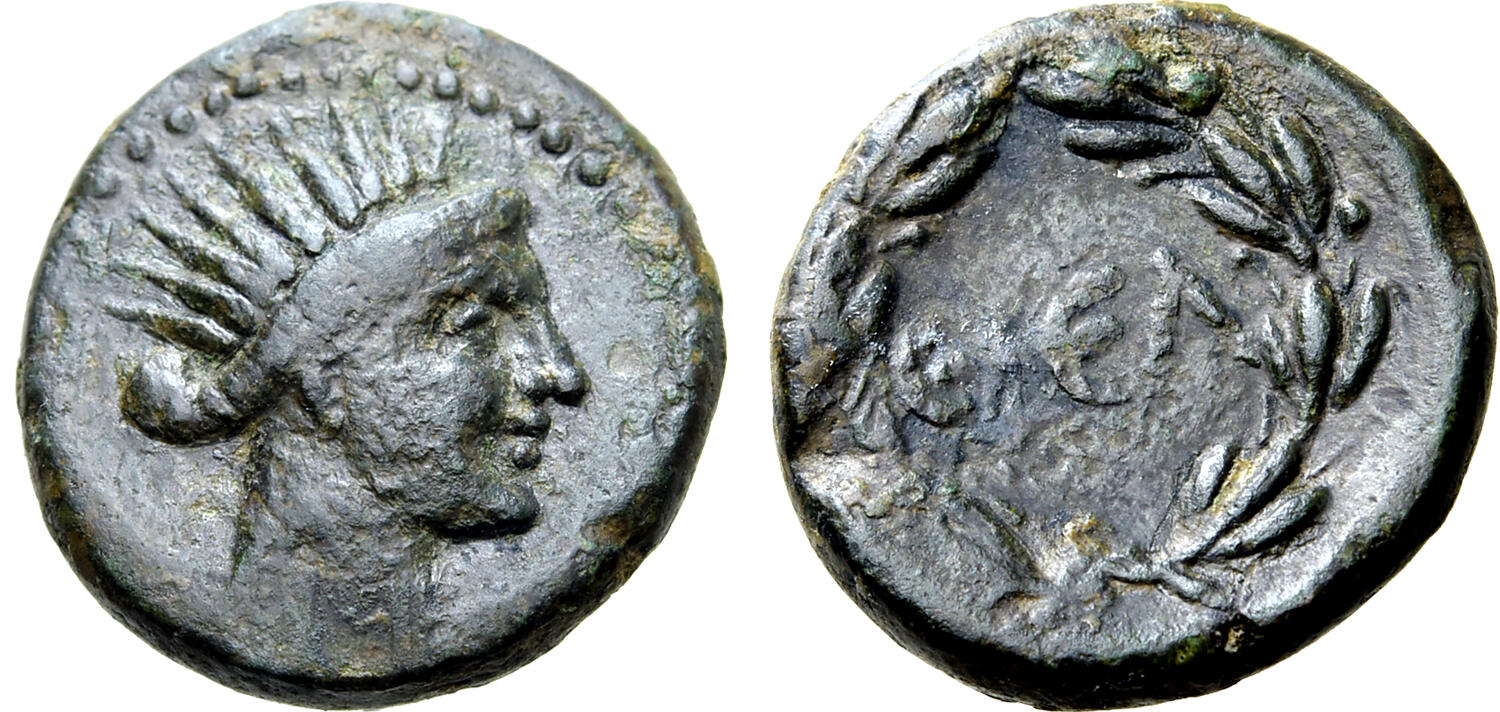Thelpusa, bronze (Demeter/wreath) (50-25 BCE)
From SILVER
50 BCE - 25 BCE Bronze
Description
| ObverseInscription or printing placed on the obverse.: | Radiate head of Demeter to right |
| ReverseInscription or printing placed on the reverse.: | ΘЄΛ (Greek).ΘЄΛ within laurel wreath |
Mint and issuing power
| MintIdentifies the place of manufacture or issue of a numismatic object.: | Thelpusa | Ancient regionAncient region.: | Peloponnesus | Modern countryModern country: Greece | AuthorityIdentifies the issuing power. The authority can be "pretended" when the name or the portrait of X is on the coin but he/she was not the issuing power. It can also be "uncertain" when there is no mention of X on the coin but he/she was the issuing power according to the historical sources: |
Chronology
| FromIdentifies the initial date in a range assigned in a numismatic context. | 50 BCE | toIdentifies the final date in a range assigned in a numismatic context.. | 25 BCE | PeriodTime period of the numismatic object.: Hellenistic 323-30 BC |
Physical description
| MetalThe physical material (usually metal) from which an object is made.: | Bronze |
Median weightMedian of the weights of numismatic objects (in grams). in grams | 4.00 | DenominationTerm indicating the value of a numismatic object. Examples: tetradrachm, chalkous, denarius.: | StandardStandard.: |
Image

Thelpusa bronze Demeter wreath.jpg [1]
References
| Die study referencePublication of the study: | Ziesmann 20221Ziesmann 2022, p. 50-54 | ||
| Coin series referenceReference to coin series study: | Sear I2Sear I, n° 2751, HGC 53HGC 5, n° 1087 | ||
| Coin series web referenceCoin series web references: | |||
Obverse dies distribution
| FrequencyFrequency of specimen in distribution. ᵖ | Number of obversesNumber of obverse dies. ᵖ (o) | % (o) | Number of coinsNumber of coins. (n) | % (n) | Die nameName(s) of the die(s). |
| 1 | 21 | 72.41 | 21 | 51.22 | 1, 3, 4, 6, 7, 9, 10, 12, 14, 15, 16, 18, 20, 21, 22, 23, 24, 25, 26, 27, 28 |
| 2 | 5 | 17.24 | 10 | 24.39 | 5, 8, 13, 17, 29 |
| 3 | 2 | 6.9 | 6 | 14.63 | 11, 19 |
| 4 | 1 | 3.45 | 4 | 9.76 | 2 |
| Total | 29 of 29 | 100 | 41 of 41 | 100 |
Reverse dies distribution
no distribution is available
Quantification
| Number of obversesNumber of obverse dies. ᵖ (o) | 29 | Number of singletons (o1)The number of singleton coins. ᵖ | 21 |
| Number of reverse diesNumber of reverse dies. (r) | 31 | Number of coinsNumber of coins. (n) | 41 |
| Coins per obverse dieNumber of coins per obverse die. (n/o) | 1.41 | Coins per reverse dieNumber of coins per reverse die. (n/r) | 1.32 |
| Reverse per obverse ratioRatio of obverse dies divided by reverse dies. (r/o) | 1.07 | Percentage of singletons (o1)number of coins (n) divided by the number of singletons (o1) ᵖ | 72.41 % |
| Original number of dies (O) (Carter 1983 formula)The estimation of the number of coins according to Carter 1983 ᵖ | 78.95 | Coins struck if 20,000 as average productivity per dieCoins made if the average productivity for obverses (according to Carter) is 20,000. ᵖ | 1,579,000 |
| Original number of dies (O) (Esty 2011 formula)The estimation of the number of coins according to the singleton formula in Esty 2011 ᵖ (O) | 99.08 | Survival rate if 20,000 as average productivity per dieSurvival rate if average productivity is 20,000. ᵖ | 0.00003 |
| Coverage (o = % of O) (Esty 1984 formula)Esty 1984 - coverage (% of O) ᵖ (o = % of O) | 48.78% | Die productivity if survival rate 1/2,000Average productivity if survival rate is 1/2,000. ᵖ | 1,038.63 |
| Weight of silver (in kg) if 20,000 coins per die (O = Carter formula)Carter 1983 * Median weight * 20000 (*10 if gold or electrum) ᵖ | n.a. | Die productivity if survival rate 1/5,000Average productivity if survival rate is 1/5,000. ᵖ | 2,596.58 |
Remarks
Most likely one single workstation
References
- ^ Ziesmann, Sonja (2022), "Zur vorkaiserzeitlichen Münzprägung von Thelphousa," Schweizerische Numismatische Rundschau, 100, p. 33-61, pl. 3-4.
- ^ Sear, David R. (1978), Greek coins and their values. Vol. I, Europe, London, xl, 316 p.
- ^ Hoover, Oliver D. (2011), Handbook of Greek Coins 5. Coins of the Peloponnesos, Achaia, Phleiasia, Sikyonia, Elis, Triphylia, Messenia, Lakonia, Argolis, and Arkadia, Sixth to First Centuries BC, Lancaster (PA), 2011.